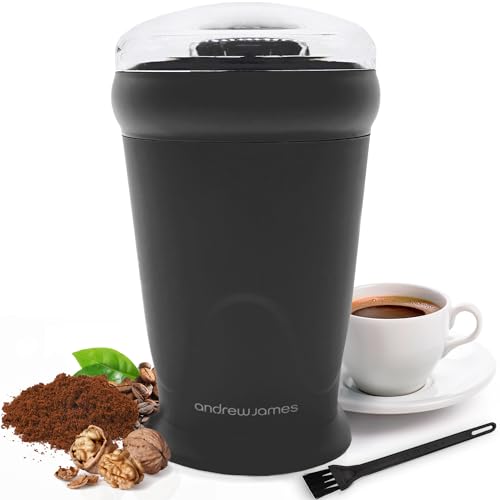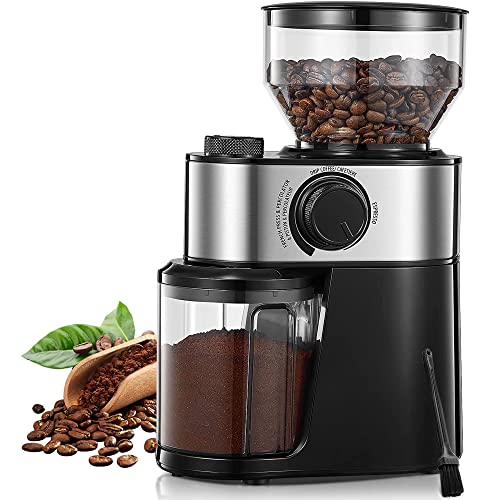Blog entry by Audrea Nicastro
How to Choose the Best Burr Coffee Grinder
A grinder is one of the most essential tools in the coffee-making arsenal. But which one to buy?
 Burr
grinders crush beans between two revolving, serrated surfaces
rather than cutting them with blades. They're generally
considered to be superior to blade grinders. But what are the
features you should be looking for in a burr grinder?
Burr
grinders crush beans between two revolving, serrated surfaces
rather than cutting them with blades. They're generally
considered to be superior to blade grinders. But what are the
features you should be looking for in a burr grinder?
1. Conical Burrs
A conical burr mill has sharp teeth that are angled and an elongated burr ring that is inserted inside the other. This design allows it to grind more efficiently as the burrs turn around a central point. The conical teeth are more efficient at cutting the beans evenly and produce less heat. This is a good thing since excessive heat can create bitter taste in your coffee. Conical burrs are also more durable than flat burrs. Flat burrs can warp and dull quickly, leading to unevenly ground espresso that is not evenly ground. They also tend to be more brittle, which means that small stones or other debris could cause damage to the burrs over time. Flat burrs also generate more noise and require regular maintenance and cleaning.
Many burr grinders that are on the market claim to be "burr grinders," but they have flat burrs or no burrs whatsoever. These "false" burr grinders have large, flattened teeth. They are often paired up with weak motors which produce inconsistent grounds. They aren't true burr mills and, contrary to what some people think, they do not offer the same grind as real burr mills.
Although some experts do not agree some believe that the burrs that are used in the grinder have an impact on the final taste of the coffee. These theories are mostly speculative, but they have gained a strong hold on the minds of coffee enthusiasts. Some believe that conical burrs bring out the distinctive flavors of exotic beans, while flat burrs soften and enhance darker roasts.
It could be true. However, it's something to consider when you are deciding whether your grinder will have a significant effect on the quality of your espresso. The only way to determine for sure is to test a grinder out with the beans you will be using it with. The overall design of the grinder and its operational features will have a larger impact on the final cup of coffee grinders than the type of burrs. This is why it's essential to assess a grinder based on other criteria, such as the reputation of the brand as well as reviews from customers.
2. Convenience
The Baratza Encore burr grinder is one that many coffee lovers swear by. It has been praised by numerous reviewers as a "time tested option" that offers great value for money and well-suited for French press, French drip, and cold brew.
According to the company, the grinder makes use of rotating metal burrs rather than blades to grind beans. This results in more uniform grounds than a grinder or other burr grinders. The burrs also produce less heat, which preserves the flavor and aroma of the beans.
Blade grinders on the other hand they can generate excessive heat and unevenly-sized grounds which can affect the flavor of your final cup. Burr grinders are also quieter than blade grinders. However, this may differ by model and brand.
Some burr grinders use flat burrs instead of conical burrs. These are two discs with cutting edges that face each opposite. We do not recommend them for espresso because they tend to be more difficult to calibrate and are generally more expensive than a top-of-the-line, flat-burr burr grinder like the Fellow Ode Gen 2 or the Baratza Virtuoso+.
Some of the grinders we've tested allow users to choose the amount of time it will be grinding for a particular period of time, which is helpful when making espresso. Some, like our top pick the Baratza Sette270 an integrated intelligent timer that can provide split-second precision. However, this feature isn't essential for all brewing methods and most under-$200 burr grinders use what's a fancier version of the windup timer.
The cheapest models, like the Porlex II or the Capresso infinity, utilize manual burrs. This means you need to turn them manually yourself to grind your coffee. This is more laborious however, it's a good option if you're looking to get an easy, compact, and affordable alternative that doesn't require electricity.
The Breville Smart Grinder Pro is another option for those who want to save money and uses a burr grinder. It's louder than the other models we've tested however it's still acceptable in the event that you're okay with a little noise. In general, the more expensive the grinder is more quiet it's likely to be due in part to the improved materials and the latest soundproofing technologies.
3. Easy of Use
A burr grinder is a device that every expert recommends for those who are just beginning to learn about home coffee making. These grinders create a finer, more consistent grind than a blade grinder. They can help you create brews with better balance in acidity, flavor and body. They are typically more reliable. As you'd imagine, a top-quality burr mill can cost anywhere from $200 to $200 and is a challenge to use.
We spoke with experts and got their suggestions for the most user-friendly electric burr grinders on the market. They recommend the OXO conical burr grinder for many people as well as those who don't want spend a fortune. It has multiple settings to manage a variety of options for brewing, from pour-over to French press, to drip coffee beans and grinder. It also did well in our tests.
It's also quieter than other electric grinders we've tested, and doesn't generate more heat. This is important because excessive heat can destroy the delicate aromas of your beans.
The OXO grinder has one flaw that it is best coffeee grinder suited to grinding at the coarser side of the spectrum. This can be problematic for espresso. If you like to brew espressos, a grinder with more advanced features like the Baratza Encore may be a better option.
Manual burr coffe grinders powered by cranking are easier to use and perfect for those who consume only about a cup of coffee every day. They're a good choice for those who travel or need to make just one portion of pour-over.
Chris Morocco, Bon Appetit Test Kitchen's director, loves the Fellow Ode Gen 2 Burr Grinder. It has 41 settings that can be easily adjusted and produces a wonderful coffee using any method, except for espresso (the flat-steel burrs don't grind finely enough). It's easy to operate for those who don't mind some messes and flyaway chaff, and it's quiet.
4. Cost
 A
quality burr mill can cost you around a hundred dollars, but it's
very worthwhile. The grinding mechanism is simple enough that
even a beginner can figure out how to get the most out of it, and
you'll save money in the long run by ditching the pre-ground
coffee and bad-for-the-environment coffee pods.
A
quality burr mill can cost you around a hundred dollars, but it's
very worthwhile. The grinding mechanism is simple enough that
even a beginner can figure out how to get the most out of it, and
you'll save money in the long run by ditching the pre-ground
coffee and bad-for-the-environment coffee pods.
Conical burr grinders are the standard in electric home units, and they're a great choice for most people just starting out with this whole grinding-your-own-beans-at-home thing. The grinders create a tiny amount of fines, which are little bits of coffee ground that are smaller than the size of grind you select. However it's not noticeable to most coffee drinkers.
Flat burrs, which are two discs with cutting teeth that are facing each other, are less common in home units but are preferred by serious coffee geeks for their ability to create an even grind size which is ideal for espresso coffee grinder and French press. The downside is that they are expensive to purchase, and you may require a new burr for each different brew type or roast level.
According to our experts, the Baratza offers the most cost-effective combination of price and capabilities for a burr mill. It's priced at less than $200, which is a lot less than many competing models that don't have the same capabilities. It has an incredibly flat 64-mm burr set that's excellent for all brewing methods and is easy to upgrade with other sets like those from SSP.
The OXO is a good affordable option that has a good performance record in our tests. Its burrs aren't quite as precise as those of pricier models, but it has various settings that work for drip and French press and its user interface is simple. While true coffee geeks will want a more advanced model but the OXO is a great starter for the majority of people.
We also tried a few manual burr grinders for those who prefer grinding their coffee by hand. These are great for traveling and for people who only need to make one or two cups of coffee at a time. These models employ the same mechanism for grinding as electric burr grinders, but operate with a hand crank instead of a motor. They are also usually quieter than electric ones.
